Lemon Filled Donuts (with Meringue Topping)

These fluffy, homemade, Lemon Filled Donuts are fried to perfection, filled with thick, tart lemon curd and topped with a smooth vanilla meringue. They can also be made into a pop-able mini version. It's lemon meringue pie in a donut!
Who doesn't love a fresh fried donut? They're the donut of all donuts, in my opinion, and this lemon donut version is sure to leave you satisfied. Especially if you're a citrus lover! They're surprisingly easy to make and bonus - you get to break out the kitchen torch!
These yeast donuts are SO soft and fluffy. After frying, they get stuffed with a thick and creamy lemon curd (which uses full eggs so it's not too "eggy" tasting). Then, slather on a dollop of silky Swiss meringue buttercream and toast it up!
P.s. I'm not lying about the easy part. The lemon curd is made with full eggs and whips up in 15 minutes. The dough has surprisingly few steps and total time is mostly rise time. And the Swiss meringue is made from the leftover whites not used in the dough!
Here's everything you'll need for the lemon filled donuts - from the curd, to the donut, to the meringue.
- Eggs. Six total eggs are needed. Three full eggs will be used for the lemon curd, and the other three will get separated (yolks for the dough, whites for the meringue).
- Lemons. Fresh lemons are needed for the curd, and you will also need the zest!
- Sugar. Granulated sugar for all three components.
- Butter. Unsalted! At room temperature for the curd, and melted for the donut dough.
- Flour. All-purpose flour is used in the donut dough.
- Yeast. Instant or rapid rise yeast is used for this recipe. Be sure to check the expiration date!
- Milk. Whole milk (do not substitute another type of milk) for the donut dough.
- Oil. I use either canola or vegetable oil to fry the donuts as they have a high smoke point and no flavor.
This list probably feels rather long. That's because I'm listing every single item you will absolutely need for this lemon filled donut recipe. It's beneficial to get everything set up and ready for each component so it goes as smooth as possible!
- Medium sized saucepan
- Mixing bowl
- Fine mesh sieve
- Microplane or grater
- Whisk
- Stand mixer with dough hook attachment
- Rolling pin
- 3-inch cookie cutter or biscuit cutter (or drinking glass)
- Plastic wrap or dish towel
- Sheet pan or cooling rack
- Parchment paper
- Large heavy bottomed pot
- Metal slotted spoon, spatula, or spider
- Deep frying or candy thermometer
- Paper towels
- Chopstick or eating utensil - used to poke the hole in the donut.
- Piping bag - to insert the lemon curd (you can also use a zip-top bag). It's best to add a piping tip if you have one (makes it easier to insert), but it's not necessary.
- Glass or metal mixing bowl
- Medium saucepan
- Whisk
- Stand mixer with whisk attachment
- Offset spatula, rubber spatula, or knife
I suggest to start by making the lemon curd filling either the day before you make the donuts, or a few hours before you start the dough. This gives the curd ample time to fully set.
STEP 1: Make the lemon curd and allow it to set in the fridge, covered. Follow my Easy Lemon Curd Recipe for the most detailed instructions. This will take about 2 hours to set.
STEP 2: To make the donut dough, start by combining 1 cup of flour, salt, sugar, and yeast in the stand mixer bowl. Just give it a light whisk. Then, separate the eggs (reserve the whites in another bowl - covered - for the meringue).
Heat the milk to 110F/43℃ - check this with a thermometer. This temperature is important - too much higher and it could kill your yeast.
Whisk together the warmed milk, egg yolks, and melted butter, then pour into the stand mixer bowl and whisk it all together. Allow it to stand for about 10 minutes.
STEP 3: Attach the dough hook, pour in the rest of the flour, and mix on medium speed for 5 minutes. The dough will feel slightly tacky, but not sticky, and will have started to mostly pull away from the sides of the bowl. The bottom will likely still stick, though!
STEP 4: Transfer the dough to a floured surface and knead by hand for another 5 minutes. If you pull off a small piece of dough and gently pull it in 4 directions, you'll be able to slightly see through it. This is called the window pane test and is how you know your dough is ready!
Grease a large mixing bowl, place the dough in, and cover with plastic wrap or dish towel. Place the bowl in a warm (not hot) location in your house and allow it to rise - doubling in size.
Take a picture of your dough! This way, you have visual evidence of how far it's risen and when it's ready.
STEP 5: Once the dough has doubled in size, lightly flour the work surface and rolling pin and turn the dough out. Roll it out until it's about ½" thick. Then, use a cookie cutter to stamp out as many donuts as you can.
I used a 3-inch cookie cutter for the normal sized donuts, but also used a 1.5-inch cutter to make mini donuts/donut holes! Transfer the donuts to a parchment lined pan and cover them lightly with plastic wrap (so they have room to rise).
Re-knead any of the scraps, roll out again, and cut out the remaining donuts. I can typically get 9 in the first round and the final 3 from the re-roll. Transfer the pan to a warm location and allow them to rise for another 30 minutes.
STEP 6: About 10 minutes before the donuts are done rising, prepare the cookie sheet (or a wire rack) with paper towels, and gather your frying thermometer and slotted metal utensil.
STEP 7: Add the entire quart of oil to a large heavy bottomed pot and turn on medium heat. You want a pot where the oil will be around 3 inches high. Keep an eye on the temperature and get it to a steady 350℉/177℃, adjusting higher or lower as needed.
Add two to three donuts at a time, frying for about 1-1.5 minutes on each side, until a nice golden brown color is formed. Transfer the donuts to the paper towels. Re-adjust for the correct temperature in between each round of frying.
Swiss Meringue
STEP 8: Make a Bain Marie and add the egg whites and sugar and whisk to combine. Continue lightly whisking until the mixture is warm and the sugar granules have dissolved. Check this by rubbing your fingers together in the mixture. If you can still feel sugar granules, keep cooking!
Once the mixture is ready, transfer it to the bowl of a stand mixer fitted with the whisk attachment (or use a handheld mixer) and whip on medium speed for about a minute. Turn to high speed and whip until stiff peaks form.
Once the meringue hits stiff peaks, add the vanilla then mix once more to combine. The meringue is ready when the bowl can be turned upside down without any movement or sliding and holds a peak on the tip of the whisk without falling.
STEP 9: Use a chopstick or thin side of a spoon/utensil to poke a hole into the side of each donut, pressing in about ⅔ of the way. Gently move the chopstick around in a circular motion to compact some of the dough and open up space for the filling.
STEP 10: Transfer the lemon curd to a piping bag - it's helpful if you have a piping tip you can use, but is not needed. Gently squeeze in the curd until it presents some "give" and feels heavy. Repeat with all donuts.
Step 11: Use a spoon or an offset spatula to add a large dollop of meringue to the top of each donut, and give it a swoop or swirl. Use a kitchen torch to toast the meringue. This step is optional, but makes for the best color and flavor.
Step 12: EAT THEM!!!
If you don't want to make the lemon curd, you could also fill the donuts will lemon jam or preserves! Additionally, if you aren't interested in adding the meringue, you could toss the donuts in a mixture of granulated sugar and lemon zest.
Be sure to rub the lemon zest into the sugar before hand to make it super flavorful. Toss the donuts to coat them immediately after they come out of the fryer.
These lemon filled donuts should be eaten the same day they are assembled. Alternatively, you could store the fried donuts in a zip-top bag for a day, then fill the next day.
If you need to freeze the donuts, do so at the stage after you cut them out. Place the cut donuts on a sheet pan and flash freeze for 30 minutes, then transfer to a zip-top bag and remove all air. Store for one month in the freezer.
Transfer the donuts to the fridge to thaw, then place on parchment lined baking sheet, lightly cover with plastic wrap, and allow to rise for one hour in a warm location. Fry as instructed.
The donuts are cooked when they are golden brown on the outside, and light and pillowy on the inside. A 190℉ center is what you're aiming for if you want to get technical.
Why are my donuts raw inside?This could be for a couple reasons. The oil temperature was too low (or at the correct temperature) and they were not cooked for long enough. Or, the oil was too hot, so the outsides cooked and browned too fast before the inside could finish cooking.
What is the difference between a baked and fried donut?Well, pretty much exactly that! Additionally, most baked donuts are make using a cake-type batter with baking soda or baking powder, and most fried donuts are make using yeast. There are fried cake donuts and baked yeast donuts though, but the above description is what you'll typically find.
What is the best type of donut?This is completely a personal preference! Baked donuts tend to be slightly healthier due to omission of frying, but they lack the sought after texture of a fried donut.
- Coffee Toffee Baked Donuts
- Banana Nut Muffins
- Fruit & Cream Cheese Puff Pastry Danish
Be sure to tag me on Instagram @thecozyplum and use I can't wait to see your creations. For more ideas, follow me on Pinterest.
Lemon Filled Donuts (with Meringue Topping)
Recipe details
Ingredients
Lemon Curd
- 3 large eggs
- 1/2 cup granulated sugar 100g
- 3 tablespoons lemon zest
- 1/3 cup lemon juice freshly squeezed
- 6 tablespoons unsalted butter room temperature (85g)
Donut Dough
- 3 cups all-purpose flour 360g
- 1/4 teaspoon kosher salt
- 1/3 cup granulated sugar 67g
- 2 1/4 teaspoons instant yeast 7g, one pack
- 3/4 cup whole milk warmed to 110℉, (180ml)
- 3 large egg yolks reserve the whites for meringue
- 1/4 cup unsalted butter melted (57g)
- 1 quart canola or vegetable oil
Swiss Meringue
- 3 large egg whites
- 3/4 cup granulated sugar 150g
- 1 teaspoon vanilla paste or extract
Instructions
Lemon Curd
- Zest about two lemons until you have 3 tablespoons of zest. Cut and juice the lemons until there is ⅓ cup of lemon juice - remove any seeds. Cut the butter into tablespoon pieces and place a fine mesh sieve on top of a bowl.
- Add the eggs, sugar, lemon juice and lemon zest to a medium saucepan over medium low to medium heat.
- Whisk constantly until the curd thickens considerably and it just starts to bubble, about 5 minutes.
- Transfer the curd to the fine mesh sieve and pass it through into the bowl using a rubber spatula or wooden spoon. Scrape the underside of the sieve to remove all curd.
- Adding one tablespoon of butter at a time, whisk it in completely to combine before adding the next tablespoon of butter.
- Cover the lemon curd with plastic wrap, placing the wrap directly onto the curd to prevent a skin from forming. Chill for 1-2 hours.
Donut Dough
- Whisk together 1 cup of the flour, salt, sugar, and yeast in the bowl of a stand mixer.
- In another bowl, whisk together the warmed milk (110℉), egg yolks and melted butter, then add to the dry ingredients and whisk to combine. Allow it to sit for 10 minutes.
- Add the dough hook to the stand mixer, add the remaining 2 cups of flour, then beat on medium speed for about 5 minutes until the dough starts pulling off of the sides slightly (it will still be mostly stuck to the bottom).
- Lightly flour a clean surface, remove the dough from the bowl (I like to use a hard plastic spatula for this), then knead for about 5 minutes.
- Lightly grease a large bowl with oil or cooking spray, add the ball of dough, and cover with plastic wrap. Transfer to a slightly warm location to rise for about an hour, or until the dough doubles in size.
- Prepare a cookie sheet with parchment paper so it's ready for the cut donuts later on.
- Lighty flour your work surface again, then turn out the dough and roll it out to ½" thick. Use a 2½ inch cookie cutter to cut out rounds of dough and transfer to the parchment lined cookie sheet.
- Cut out as many as possible, then re-knead & re-roll the scraps and cut out additional donuts. You should be able to get 12 donuts out of the dough.
- Cover the donut rounds with plastic wrap and allow to rise in a warm place for another 30 minutes.
Frying the Donuts
- Add the canola or vegetable oil to a large, heavy bottomed pot over medium heat until it reaches 350℉/177℃ on a thermometer. You'll want to keep an eye on the temperature in between every batch, keeping it as close to this temperature as possible by adjusting your heat accordingly.
- Fry 2-3 donuts at a time for about one minute on each side until a nice golden color.
- Remove to a wire rack or cookie sheet lined with paper towels and repeat until all donuts are fried.
Swiss Meringue
- Fill a saucepan with about 1 inch of water and turn to high heat. Add a heat proof bowl over top that fits securely. You don’t want any of the water touching the bottom of the bowl.
- To the bowl, add the egg whites and sugar and whisk to combine. Continue lightly whisking until the mixture is warm and the sugar granules have dissolved. Check this by rubbing your fingers together in the mixture. If you can still feel sugar granules, continue cooking. If you have a thermometer, cook it to around 150℉/66℃.
- Once the mixture is ready, transfer it to the bowl of a stand mixer fitted with the whisk attachment (or use a handheld mixer) and whip on medium speed for about a minute. Turn to high speed and whip until stiff peaks form.
- Once the meringue hits stiff peaks, add the vanilla then mix once more to combine. The meringue is ready when the bowl can be turned upside down without any movement or sliding and holds a peak on the tip of the whisk without falling.
Donut Assembly
- Transfer the lemon curd to a piping bag and snip a small hole for the tip.
- Use a chopstick to puncture a hole into the side of the donut, insert it about ⅔ of the way, and carefully move it in a circular motion to open up the space for the filling.
- Gently squeeze lemon curd into each donut until it just peeks out of the hole. You will feel some pressure as it's almost filled and the donut will feel heavier.
- Use an offset spatula or spoon to add a dollop of meringue to the top of each donut and add swoops or swirls.
- Use a blow torch to lightly toast the meringue portion of each donut.
- The donuts are best enjoyed immediately after assembly, and should be eaten the same day.
Tips
- Visit my Easy Lemon Curd Recipe for detailed instructions on how to make the curd. It's best to make the lemon curd the day before so it has time to set up.
- Store the assembled donuts at room temperature for one day.




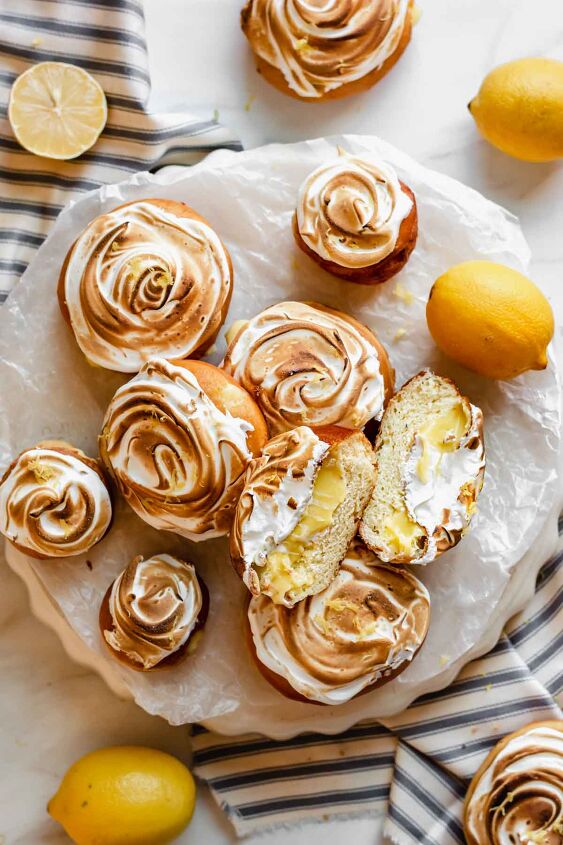












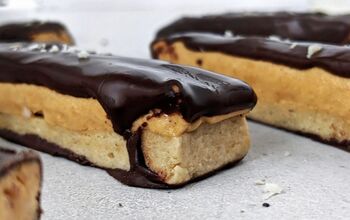
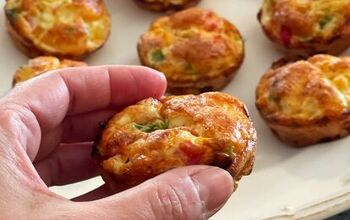


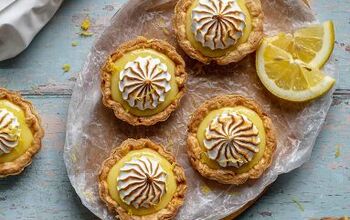
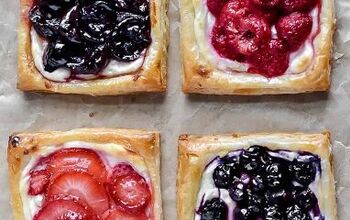

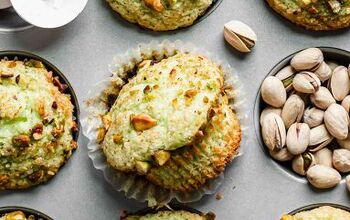


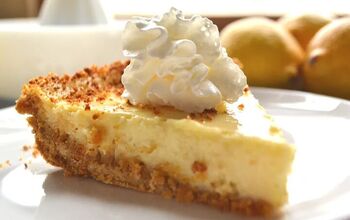
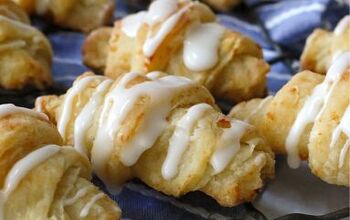

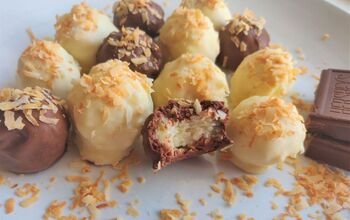


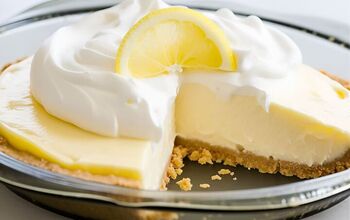
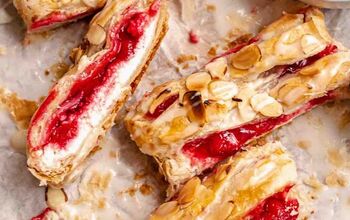
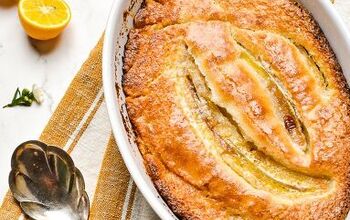
Comments
Share your thoughts, or ask a question!